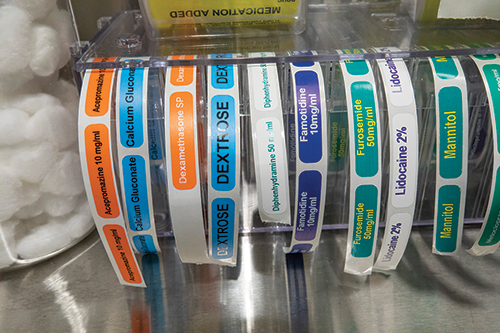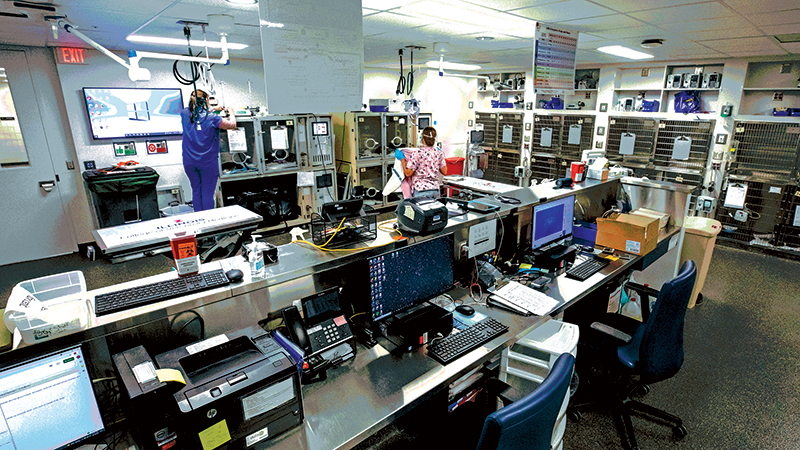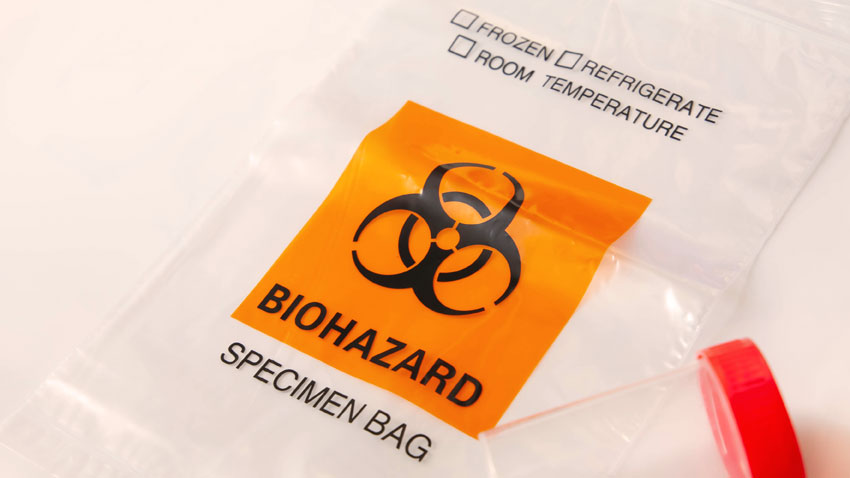Our critical care service re-opened in October! Our team consists of five boarded criticalists, two emergency clinicians, three emergency and critical care residents, one specialty intern, and veterinary technicians providing around-the-clock care in our intensive care unit. With a team-centered approach, the critical care service is dedicated to providing intensive monitoring and expert care for critically ill, injured, and postoperative patients while they are hospitalized in our ICU.

How Do I Refer a Patient?
If you are a veterinarian who is considering referral of a patient for one of the extracorporeal therapies, please consult with one of our faculty criticalists by calling 217-333-5311 prior to referral.
Collaboration with our other hospital services allows us to optimize care utilizing collective knowledge and expertise to customize treatment plans to meet each patient’s individual needs and improve their recovery. Our critical care service can provide specialized therapies such as high-flow nasal oxygen; mechanical ventilation; point-of-care ultrasound including advanced cardiac function and volume assessment; biomarker testing (troponin, cortisol, feline and canine proBNP); standard coagulation testing; advanced viscoelastic testing; canine and feline blood component transfusion therapy.
The emergency and critical care service is also excited to launch our brand-new Extracorporeal Service in 2024! This new service will allow us to provide advanced blood processing or blood filtration treatment options including therapeutic plasma exchange (TPE) for treatment of severe immune-mediated diseases and acute intoxications or drug overdoses, as well as hemodialysis for the management of life-threatening acute kidney injury.
What Is an Extracorporeal Therapy?
This is a process by which blood is removed from the patient’s circulation and filtered or processed by a specialized machine before returning to the patient. Renal replacement therapy, also known as hemodialysis or dialysis, is the most well-known blood filtration therapy. It can be performed using either an intermittent or continuous treatment protocol.
Cardiac bypass and extracorporeal membrane oxygenation are also considered extracorporeal therapies that are primarily used in human medicine but can be found in a handful of veterinary facilities around the world.
Hemoperfusion, also called therapeutic plasma exchange (TPE), is another type of extracorporeal therapy in which only the plasma portion of the blood is removed and then replaced with donor plasma or another type of replacement fluid. This therapy is especially useful for severe immune-mediated diseases to remove immunoglobulins that are causing abnormal destruction of specific cell lines.
TPE is also very useful for treating acute intoxications or drug overdoses in which the toxin binds to proteins in the bloodstream, specifically albumin. During the process of removing the animal’s plasma, the drug or toxin is also removed, thereby reducing the risk of fatal complications and secondary organ failure, as well as decreasing the duration of hospitalization following a severe intoxication or drug overdose.
Hemodialysis in dogs and cats is performed very similarly as it is in people, with the main difference being when dialysis is initiated. In veterinary medicine, dialysis is utilized in the acute phase of kidney injury whereas in human medicine dialysis is used in the chronic stages of injury or as a bridge to kidney transplant. Most animals that develop acute kidney injury will respond to standard medical management. However, patients that become refractory to traditional therapies are often left with extremely limited treatment options. The criteria for considering dialysis include progressive uremia in the face of oliguria-to-anuria, fluid-overload, and severe electrolyte or acid-base abnormalities.
The main goal of dialysis is to filter out uremic toxins from the bloodstream, remove excess fluid from the body, and normalize electrolytes or acid-base changes while allowing the kidneys the time they need to recovery from the primary injury/insult.
By Jenica Haraschak, DVM, MS, DACVECC




